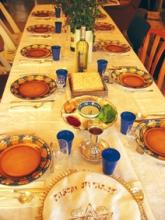Every spring, Jews all over the world gather with their families and friends to perform the most complex ritual of the Jewish faith, the Passover Seder. A Seder is a meal of storytelling, a multi-sensory experience of symbols commemorating one of the most important moments in the Torah. Passover celebrates the release of the Hebrew slaves from captivity in Egypt, the beginning of a people's freedom and also its entry into the difficulty of self-governance. But there's more to the Seder than just the lessons of biblical scripture. If the story was the only purpose of the ritual, we could just as easily gather at the synagogue like we do on Rosh Hashanah and Yom Kippur. The story is our past, an important thing to be sure, but the Seder asks us to focus on our present and future as well.
The word "Seder" is a Hebrew term meaning "order". It refers to the symbolic courses of the meal, which come in a sequence that tells a story about the emotions tied to the captivity and eventual release of the Hebrews from slavery in Egypt. The symbolic portion of the meal involves, among other things, four cups of wine, each of which stand for something different. The first cup begins the Seder as a welcome to all in attendance. The second follows the recitation of The Four Questions, a gesture indicating that inquisitiveness and study are themselves blessed acts. However, before the second cup is consumed, it is traditional to remove ten drops, one for each of the ten plagues visited upon Egypt in recognition of the sorrow they caused. The third cup is consumed after the non-symbolic meal as a blessing of thanks. The fourth and last cup is consumed in association with the story of Elijah the prophet, a symbol of hope for the future.
The symbolic meal also includes small amounts of various foods, such as the bitter herb (today usually horseradish) to symbolize the pain of oppression, and the karpas, a green vegetable dipped in salt water, that symbolizes the eventual "spring" of the Hebrews in freedom tempered by the tears of their sorrow.
Anyone who has ever attended a big Seder will tell you that these symbolic foods, while important, make up a rather small portion of what actually happens during the meal. The lion's share of the Seder involves the same things that happen any time friends and family gather around a table for an evening. People converse, laugh, meet for the first time or catch up after a long period away from one another. There are dramas and moments of growth, a chance to take stock of one's life in an evening outside of routine. The ritual is certainly meaningful, but not more so than the singular intersection of lives that occurs around the table of a feast.
Half joking but still plausible is the idea that the four traditional cups of wine are a way to ensure that everyone lingers at the Seder longer than they would for a more sober ritual. Even if the prayers and other components of the Seder go by quickly, drunkenness runs its course in its own time. We recline, eat, drink, sing and joke at the Seder because we need a reason beyond faith and devotion to join together with others. Just as the story in the Torah describes, it's not enough to simply grant people freedom. They must also form a community by their own means, finding common ground in their truly disparate lives. In the end, what is more common than the need to eat?
